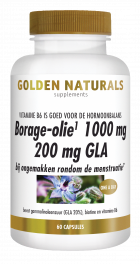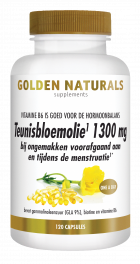GLA in borage and evening primrose oil: which one is best for you?
- Jan 5, 2022
It is well known that hormones can have a major influence on our mood. Due to the changing hormone balance during the menstrual cycle, women can suffer from irritability or tenderness of the breasts. Are your hormones playing up around your monthly cycle? Then borage or evening primrose oil from Golden Naturals can be a good support. What exactly is the difference between the two flowers? What are the active ingredients in these products? And when do you use them?
Borage flour is the richest GLA source
The borage plant (Borago officinalis) is a well-known shaggy herb with blue flowers. The flowers are edible and are regularly used in dishes. These taste a bit like cucumber, which is why the flower is nicknamed cucumber herb. The borage plant originated in countries around the Mediterranean and then spread across Europe and North America. The flowers are rich in choline, glucose, fructose, amino acids and tannins. The seeds mainly contain proteins and an oil rich in gamma-linolenic acid (GLA). Borage oil is the richest natural source of gamma-linolenic acid (GLA).
Borage dangerous?
We can be brief about this: borage is not dangerous for consumption. Sometimes there are doubts about the safety of borage. That's because the herb contains certain toxins to protect itself from enemies. Many herbs and plants do this. However, research shows that these amounts are so low that they do not pose a risk for consumption of borage. In addition, borage oil is extracted from the seeds of the borage plant by means of cold pressing. During this process, the oil is purified of all potentially harmful substances. As a result, the oil amply meets the statutory standard and borage oil supplements are safe to use.
evening primrose
Evening primrose (Oenothera biennis) is an herb related to the fireweed and is known for its beautiful yellow flowers. The evening primrose is originally from North and South America. The flowers open between 6 and 7 p.m. That is why the evening primrose is nicknamed 'Night Candle' and the English name 'Evening Primrose'. The flowers smell wonderful, a bit lemony. Although not edible, an oil rich in gamma-linolenic acid (GLA) can be extracted from the seeds.
What is gamma linolenic acid (GLA)?
Gamma-linolenic acid (GLA) is a polyunsaturated omega-6 fatty acid that unfortunately hardly occurs in our diet. Fortunately, the body itself can make GLA from (cis)linoleic acid. We get plenty of linoleic acid through our diet and you can find a lot in vegetable oils such as sunflower oil. Yet there are relatively few foods from which you can get GLA. That's why a borage oil supplement is often a welcome addition to your diet!
Borage oil: high GLA content from vegetable source
What does GLA do for your health?
GLA has several health benefits. It can be converted into other unsaturated fatty acids, such as prostaglandins and leukotrienes. These are hormone-like substances that regulate various processes in the body*. You can think of the resistance, digestion and brain functions. They also help to balance hormones*. For example, prostaglandins help maintain regular periods. In addition, they support discomfort before and during menstruation*. But that's not all: GLA also vitalizes the skin and protects it against aging*. It supports the skin's natural ability to retain moisture. It nourishes the skin from within and helps to maintain the elasticity and softness of the skin. This keeps the skin looking smooth and radiant.
Which Supplements Contain GLA?
Sometimes the conversion of linoleic acid to GLA does not run optimally. This has various causes, such as a (too) high consumption of trans fatty acids, saturated fats, sugar, alcohol and carbohydrates. These factors can lead to an above-average need for GLA. Then it may make sense to supplement this with a supplement. Evening primrose oil and borage oil are one of the richest sources of GLA. Most vegetable oils contain a lot less of this essential acid. Oil is pressed from the seeds of the borage primrose and evening primrose and used in capsule form GLA supplements. Borage oil contains more GLA than evening primrose oil. This difference is reflected in the amount of mg GLA per capsule, which is higher with borage oil. When using polyunsaturated fatty acids such as GLA, it is recommended to take sufficient vitamin E, a fat-soluble antioxidant.
Golden Naturals Borage Oil 1000mg 200mg GLA
Golden Naturals Borage Oil contains 1000 mg of pure borage oil per softgel capsule, of which 20% is GLA. One capsule of borage oil provides 200 mg of GLA. To protect the fatty acids against oxidation, 10 mg of vitamin E has been added per capsule. Biotin is good for the skin and vitamin B6 is good for the hormone balance.
Golden Naturals Evening Primrose Oil 1300 mg
Evening primrose oil from Golden Naturals contains 1300 mg of evening primrose oil of which 9% GLA. Biotin and vitamin B6 have also been added to this product. Biotin is important for the skin and vitamin B6 is good for the hormone balance.
*Evaluation health claim is ongoing.





